Results 7,571 to 7,580 of 12091
Thread: Anandtech News
-
11-28-17, 08:32 AM #7571
Anandtech: NVIDIA Releases Maxwell-based GeForce MX130 & MX110 Mobile GPUs
Earlier this month, NVIDIA quietly released the Maxwell-based entry-level GeForce MX130 and MX110, joining the earlier Pascal-based MX150. The MX130 and MX110 product pages were later updated to specify that they were Maxwell-based parts. These discrete mobile GPUs are OEM-focused, and fill out the very bottom of NVIDIA’s mobile GPU product stack.
Officially, as with previous low-end GPU launches, NVIDIA is remaining tight-lipped on formal GPU specifications. In lieu of hard numbers on CUDA cores and clocks – the latter of which is variable among laptop designs due to power and cooling – NVIDIA is citing performance relative to the Intel UHD 620, the iGPU featured in the i5-7200U (and most other Intel 8th Gen Core CPUs). There the company has the MX110 listed as 1.5x faster in games than the UHD 620, while the MX130 is cited as 2.5x faster. In comparison, the MX150 was cited at 4x faster than the Intel's iGPU.
[TABLE="align: center"]
[TR="class: tgrey"]
[TD="colspan: 6, align: center"]Best Guess: NVIDIA Laptop Video Card Specification Comparison[/TD]
[/TR]
[TR="class: tlblue"]
[TD="class: contentwhite, width: 206, bgcolor: #016a96, align: center"] [/TD]
[TD="class: contentwhite, width: 136, bgcolor: #016a96, align: center"]MX150[/TD]
[TD="class: contentwhite, width: 136, bgcolor: #016a96, align: center"]MX130[/TD]
[TD="class: contentwhite, width: 137, bgcolor: #016a96, align: center"]MX110[/TD]
[/TR]
[TR]
[TD="class: tlgrey"]CUDA Cores[/TD]
[TD="bgcolor: #f7f7f7, align: center"]384[/TD]
[TD="bgcolor: #f7f7f7, align: center"]384[/TD]
[TD="bgcolor: #f7f7f7, align: center"]256[/TD]
[/TR]
[TR]
[TD="class: tlgrey"]ROPs[/TD]
[TD="bgcolor: #f7f7f7, align: center"]16[/TD]
[TD="bgcolor: #f7f7f7, align: center"]8[/TD]
[TD="bgcolor: #f7f7f7, align: center"]8[/TD]
[/TR]
[TR]
[TD="class: tlgrey"]Boost Clock[/TD]
[TD="bgcolor: #f7f7f7, align: center"]Variable[/TD]
[TD="bgcolor: #f7f7f7, align: center"]Variable[/TD]
[TD="bgcolor: #f7f7f7, align: center"]Variable[/TD]
[/TR]
[TR]
[TD="class: tlgrey"]Memory Type[/TD]
[TD="bgcolor: #f7f7f7, align: center"]GDDR5[/TD]
[TD="bgcolor: #f7f7f7, align: center"]GDDR5/DDR3[/TD]
[TD="bgcolor: #f7f7f7, align: center"]GDDR5/DDR3[/TD]
[/TR]
[TR]
[TD="class: tlgrey"]Memory Bus Width[/TD]
[TD="bgcolor: #f7f7f7, align: center"]64-bit[/TD]
[TD="bgcolor: #f7f7f7, align: center"]64-bit[/TD]
[TD="bgcolor: #f7f7f7, align: center"]64-bit[/TD]
[/TR]
[TR]
[TD="class: tlgrey"]VRAM[/TD]
[TD="bgcolor: #f7f7f7, align: center"]
-
11-28-17, 11:17 AM #7572
Anandtech: ASUS Announces ROG Strix XG32VQ and ROG Strix XG35VQ: Large, Curved, & Fas
ASUS has quietly added two large curved displays to its lineup of ROG gaming monitors. The new LCDs are based on VA panels and boast a 100 Hz and 144 Hz refresh rates (depending on the model) along with AMD’s FreeSync and ASUS’s ELMB. The ROG Strix XG32VQ features a mainstream 16:9 aspect ratio display, whereas the larger ROG Strix XG35VQ is an ultra-wide curved display that promises to be cheaper than the last year’s flagship ROG Swift PG348Q. Following the recent trends, both monitors also come with the ASUS Aura Sync RGB lighting.
As curved monitors are gaining traction on the market, ASUS and other manufacturers are expanding their lineups to address various customers with such products. The ROG Strix XG32VQ belongs to the upper mid-range segment of the gaming market and offers a rather interesting combination of features. The monitor relies on a 31.5” VA panel with a 2560×1440 resolution, 1800R curvature, 16:9 aspect ratio, as well as refresh rates between 48 Hz and 144 Hz, courtesy of AMD’s FreeSync technology. The VA panel can reach 300 nits of brightness, a rather high contrast ratio of 3000:1, a 4 ms response time, 178°/178° viewing angles and so on. Typically, VA panels are not known for the most accurate color reproduction and this particular one can display 16.7 million of colors. Nonetheless, ASUS claims that its color gamut is wider than the sRGB. As for connectivity, the XG32VQ has a rather standard set of connectors by today’s standards: an HDMI 2.0 port, a DisplayPort 1.2 input, a Mini DisplayPort 1.2 input, and a 3.5-mm audio jack for headphones.
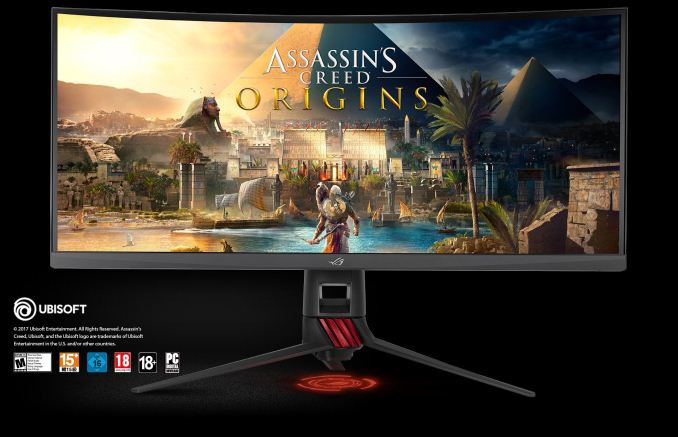
Meanwhile the ROG Strix XG35VQ is a larger monitor featuring a 21:9 aspect ratio, but lower refresh rates of up to 100 Hz. The 35” model is based on a VA panel with a 3440 × 1440 resolution, 2500:1 contrast ratio, 300 nits brightness, and a 4 ms grey-to-grey response time. Besides AMD’s FreeSync (that works in the range between 48 and 100 Hz), the display also supports ASUS’ ELMB technology designed to make fast-paced scenes look sharper. The connectivity scheme of the XG35VQ is a bit different than on the XG32VQ model: the large monitor has a DisplayPort 1.2 input, an HDMI 1.4 input, and an HDMI 2.0 input, as well as 3.5-mm headphone jack.
From ergonomics standpoint, the two monitors are very similar: both can regulate height, tilt, swivel or can be attached to a VESA wall mounting. As for ASUS’ proprietary enhancements, such as GamePlus OSD features and GameVisual modes that adjust LCD for a particular game genre, they are supported, but with some variability between models. Finally, to make the new ROG Strix monitors look like other latest ROG-branded models, the new LCDs also feature adjustable ROG signature projection on the bottom as well as the Aura Sync RGB LEDs on the back. The latter can automatically match their behaviour with the Aura Sync LEDs inside the host PC and peripherals.
ASUS is not disclosing when exactly it plans to start selling the two monitors. Since the company has published presumably final specs of the new units, they are presumably set to be available rather sooner than later. In the meantime, ASUS’ first ultra-wide curved monitor ROG Swift PG348Q based on an IPS panel and offering several advantages over the new displays is now available for less than $1,000.ASUS ROG Strix XG32VQ and ROG Swift XG35VQ Displays ROG Strix XG32VQ ROG Swift XG35VQ Panel 31.5" VA 35" VA Native Resolution 2560 × 1440 3440 × 1440 Refresh Rate 144 Hz 100 Hz Dynamic Refresh Rate Technology AMD FreeSync Range 48 - 144 Hz for DP, HDMI 48 - 100 Hz for DP, HDMI Response Time 4 ms (gray-to-gray) Brightness 300 cd/m² Contrast 3000:1 2500:1 Color Gamut 125% sRGB 100% sRGB Viewing Angles 178°/178° horizontal/vertical Curvature 1800R Inputs 1 × HDMI 2.0
1 × DisplayPort 1.2
1 × Mini DisplayPort 1.21 × HDMI 1.4
1 × HDMI 2.0
1 × DisplayPort 1.2USB Hub 2 × USB 3.0 Audio 1 × 3.5-mm audio jack for headphones Proprietary Enhancements Trace Free Technology
Color Temperature Selection: 4 Modes
GamePlus Modes: Crosshair/Timer/Display Alignment
Low Blue Light: Yes
VividPixel: Yes
GameVisual Modes: Scenery/Racing/Cinema/RTS/RPG/FPS/MOBA/sRGBULMB
Trace Free Technology
Color Temperature Selection: 4 Modes
GamePlus Modes: Crosshair/Timer/Display Alignment
Low Blue Light: Yes
GameVisual Modes: Scenery/Racing/Cinema/RTS/RPG/FPS/sRGB
GameFast InputPower Consumption Idle ~0.5 W Active 43 W at 200 cd/m² Detailed Information Link Link
Buy ASUS ROG Swift PG348Q on Newegg
Related Reading:
- ASUS Starts to Ship Its First Curved Ultra-Wide Display: ROG Swift PG348Q
- ASUS Launches ROG Swift PG27VQ: Curved 27-inch LCD with 165 Hz G-Sync & RGB Lighting
- ASUS ROG Strix XG27VQ Available: 27” Curved, FHD@144Hz & FreeSync w/ELMB
- Alienware Announces AW3418DW and AW3418HW Ultra-Wide Curved Displays
- LG’s 34UC89G 21:9 Curved Display with G-Sync, 144 to 166 Hz, Available for $999
- Acer Predator Z35P Available for Order: Curved 35" with 3440×1440@120 Hz and G-Sync
- Acer Predator Z271UV Gaming Monitor: 1440p, 144-165Hz, G-Sync, Eye Tracking
- AOC Expands AGON Family with Curved AG322QCX and AG272FCX 144 Hz Displays
- AOC Announces the AGON AG352UCG 21:9 Curved Display: 35", 3440×1440, 100Hz with G-Sync
More...
-
11-28-17, 12:43 PM #7573
Anandtech: Intel Xeon E3-1200 v7 Will Become Xeon Entry (Xeon E), Possible Intel with
The last 12 months have seen an upheaval of Intel’s enterprise processor naming scheme, with a distinct mix of positive and negative responses. In previous years, Intel followed a naming scheme that provided the processor positioning, some of the features, the generation, and if it was a special sub-type all in one number, which scaled from the bottom of the stack to the top. This scheme had been in place for five or six generations, but was then flipped on its head when Intel announced the change of the Xeon E5 and E7 processor lines to the Xeon Scalable Platform, Xeon-SP, using heavy metals as the naming. More recently, the workstation-focused Xeon E5-1600 line was also renamed to Xeon W, for workstation. We have learned from separate sources that in the early part of next year, the next generation of entry-level Xeon E3-1200 processors will also be renamed to Xeon E, with E for entry.
More...
-
11-28-17, 02:18 PM #7574
Anandtech: XFX to Release Custom Radeon RX Vega 56 and Radeon RX Vega 64 Double Editi
XFX has quietly introduced its first new custom Radeon RX Vega 56 and RX Vega 64 video card designs. The custom Radeon RX Vega Double Edition graphics adapters from XFX are not factory overclocked, but have an improved cooling system featuring two fans that may enable a higher overclocking potential when compared to regular air-cooled boards based on AMD’s Vega GPU.
When AMD released its reference Radeon RX Vega 64 and Radeon RX Vega 56 graphics cards earlier this year, the company surprised reviewers and enthusiasts with rather long PCBs (when compared to the Radeon R9 Fury X products) that had a lot of empty space. As it turned out, the RX Vega-series boards need a good cooling and thus a relatively large heatsink. As a result, the company decided to go with a long half-empty PCB to simplify auxiliary PCIe power cable management for end users. As for VRMs, AMD’s reference cards feature a 6+1 phase VRM based on the International Rectifier IR35217 power controller with six IR 3598 phase doublers for the GPU power circuity to maximize efficiency.
XFX decided to change design ideology of its custom Radeon RX Vega-based products when compared to AMD’s reference cards. The company’s Radeon RX Vega 56 Double Edition (RX-VEGALDFF6) and Radeon RX Vega 64 (RX-VEGATDFF6) Double Edition graphics cards rely on a notably shorter PCB that is just 153 mm long, and the cards are also equipped with an even larger cooling system when compared to AMD's reference cards (more about the cooling system later later). XFX says it uses a VRM with 6+1 phases for its graphics cards based on the Vega GPU, but it is unknown whether the company also installs phase doublers. The XFX Radeon RX Vega Double Edition cards have two 8-pin auxiliary PCIe power connectors that are located on the top right corner of the PCB. Given the large cooler, power connectors are placed in the center of the card, which will not simplify cable management.
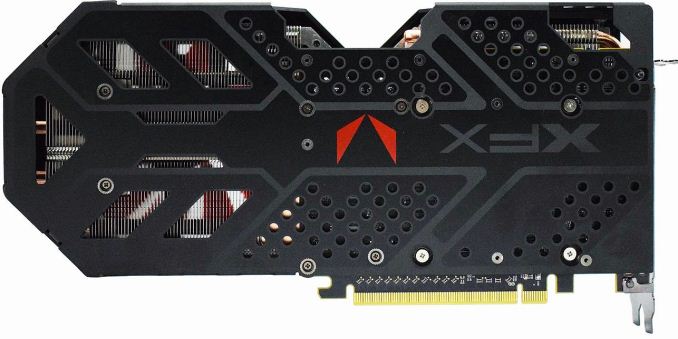
Overall, the cooler the company uses for its custom Vega-based offerings resembles coolers it uses on the Radeon RX 500-series. It features two large aluminum heatsinks with tens of thin fins, a special copper plate that covers GPU+HBM2 package as well as VRM, five or more heat pipes that take away heat from the two aforementioned components, and two fans. A plastic shroud on the front covers the cooling system, whereas the other side of the card is covered by a backplate.
The heatsink used by XFX for its Radeon RX Vega Double Edition video cards has a 75% larger surface area than AMD’s reference one, according to XFX. Meanwhile, as this is an open-air cooler design, it comes with the usual tradeoffs relative to the blower-based reference cooler: potentially better cooling and lower noise thanks to the two fans, but at a cost of recycling most of the heat generated from the card back into the case. By equipping its custom Radeon RX Vega 56 Double Edition and Radeon RX Vega 64 Double Edition with its own coolers, XFX clearly wants them to stand out from the rest of the Vega camp in terms of noise and overclocking potential. At least initially, custom Vega-based boards from XFX will only be offered with reference clocks, so overclocking potential will be one of their key selling points.

XFX has not disclosed MSRPs of its Radeon RX Vega 56 Double Edition and Radeon RX Vega 64 Double Edition graphics cards, but we are told to expect them to close to AMD's MSRPs for similar boards. Meanwhile, the burning question of when these custom cards will be available hasn't been precisely answered, but XFX has narrowed the window some, as the company has stated that they hope to put their custom cards on store shelves before Christmas. At press time, the products were listed on the company’s website meaning that they can hit the market anytime now.
As for real-world pricing, given the cryptocurrency mining frenzy and the holiday season, virtually all graphics cards are sold at prices above their MSRPs, so it is not a good business to make any predictions here. Besides, it is also unclear whether AMD’s recently launched Prey and Wolfenstein II bundling campaign covers XFX’s custom Radeon RX Vega adapters.
Buy XFX Radeon RX Vega 64 Liquid on Amazon.com
Related Reading:
- Best Video Cards for Gaming: Holiday 2017
- Game Bundles: Get Prey and Wolfenstein II for Free with AMD Radeon RX Vega & More
- Radeon RX Vega Unveiled: AMD Announces $499 RX Vega 64 & $399 RX Vega 56, Launching August 14th
- The AMD Radeon RX Vega 64 & RX Vega 56 Review: Vega Burning Bright
More...
-
11-29-17, 08:10 AM #7575
Anandtech: The MSI X299 SLI Plus Motherboard Review: $232 with U.2
Today we had an opportunity to look at another motherboard in the MSI lineup. Instead of coming from the Enthusiast, Performance, or Arsenal line of products, the MSI X299 SLI Plus hails from their Professional line of motherboards. The SLI Plus is often cited as a low-cost, 'meets almost everyone's needs' type of board, and previous iterations have worked well in the past. We put it on the test bed for a thorough inspection.
More...
-
11-29-17, 09:21 AM #7576
Anandtech: HDMI 2.1 Specification Released: Variable Refresh, Dynamic HDR, & More In
Earlier this week, the HDMI Forum, the open industry consortium for developing the HDMI specification, officially finalized and released the HDMI 2.1 specification. Previously announced in January HDMI 2.1 is a combination feature update and transport layer update that introduces and expands various bits of functionality, but also enables higher resolutions and refresh rates thanks to a new 48 Gbps cable and associated signaling.
The big news here is of course on the resolution front, where HDMI brings resolution and refresh rate support up to a colossal 10240 x 4320 pixels, or what the HDMI Forum is referring to as “10K,” at 120Hz. Less eye-catching but arguably much more important is support for dynamic HDR, variable refresh, and Enhanced Audio Return Channel (eARC) functionality. The HDMI Forum is also unveiling new features oriented for enhanced refresh rates and low latency. The official publication of the specification brings HDMI 2.1 a significant step closer to powering and connecting commercial devices.
The previously announced HDMI 2.1 specficiation continues to be very much in line with current monitor and display technology trends: ever higher resolutions at faster refresh rates, variable refresh rate functionality, and high dynamic range (HDR), all needing more and more data bandwidth. At the same time, HDMI 2.1 brings many new features over its predecessors – even over current-generation cables – one of which is dynamic HDR, where the HDR metadata is much more granular and can describe images frame-by-frame. This allows higher quality via per-scene or per-frame adjustments of contrast, brightness, detail, and more, something that is not possible for static HDR due to its same metadata essentially being applied to all the scenes and frames of the title.
The new HDMI 2.1 standard also cannonizes variable refresh into an official HDMI standard. This has grown from AMD's previous efforts in the field, where the company added FreeSync varaible refresh to HDMI as a proprietary extension. As we've seen in FreeSync and G-Sync over the last few years, variable refresh technology eliminates tearing and greatly reduces stuttering, allowing for smoother gameplay. The addition of variable refresh to the official HDMI standard means that the benefits of the technology can now be brought to a much wider range of products and content.
For eARC, the technology itself allows TVs to send audio back to a receiver or sound bar on the single connecting HDMI cable. ARC functionality is not new to HDMI, but the previous version was essentially limited to DVD-quality audio, as there wasn't enough bandwidth for newer audio standards with lossless audio or more channels. Along with enhanced auto-discovery, eARC specifies much more channel bandwidth (~37 Mbps), enabling support for high-bitrate audio formats including DTS Master and Dolby TrueHD, object-based audio including DTS:X and Dolby Atmos, uncompressed 5.1 and 7.1, and 32-channel uncompressed audio.
In real world terms, this is meant to better allow HDMI to work without a dedicated audio receiver. Rather than routing the entire 18 Gbps video + adio stream through a receiver – and all the problems that come from having a device in the chain between a source an a TV – the TV itself can be the hub of a home entertainment system, piping out audio via HDMI to a relatively simple soundbar or similar device. In other words, HDMI becomes TV-centric rather than receiver-centric. Coupled with new eARC device control and discovery capabilities, apps, consoles, set top boxes, Blu-ray players, and other media devices can be plugged directly into a TV and more easily controlled by a single TV remote.
Nevertheless, much still depends on the device manufacturers. eARC can run over some current cables and some manufacturers will be supplying firmware updates to add eARC to current products. However this varies on a product-by-product basis, and not all products can (or will be) updated to support eARC. As a result, the eARC standard will also be backwards compatible, but only in as much as it can fallback to ARC.
With all the bandwidth that these features consume, the HDMI Forum is continuing on with their 48 Gbps Ultra High Speed HDMI Cable, with its own as-yet unreleased logo and color requirements. Formerly known as the 48G cable, it remains backwards compatible with previous HDMI standards, features low EMI emission, and comes in the existing Type A, C, and D connector flavors. While the specification does not describe cable length, HDMI Licensing considers 2 to 3 meters as the maximum length for passive cables. In addition to passive cables, the specification permits wire, active, and converter Category 3 cable assemblies.
The HDMI Forum expects UHS cables to be available in the first half of 2018, noting that these cables may only ship after complying with the as-yet unreleased HDMI 2.1 Compliance Test Specification. These cables will be necessary to enable the fullest HDMI 2.1 functionality – particularly any feature that requires more bandwidth – such as 4K120 and 8K60 display modes. Chroma and bit depth considerations are also required in determining what class cable is required; HDMI 2.1 supports the latest color spaces like BT.2020 (Rec. 2020) with 10, 12, and 16 bits per color, with higher bit depths quickly eating up cable bandwidth.
Otherwise, there's a bit of good news on the cable front when it comes to eARC. The new audio channel standard doesn't require the UHS cable, but instead works over any cable with an Ethernet channel. This means it's possible for Standard, High Speed, Premium High Speed, and UHS cables to all support eARC. However not all cables (especially older cables) support the Ethernet channel, as it has not been a requirement.
Speaking of cable bandwidth, as even 48 Gbps isn't enough bandwidth for some of the resolutions and refresh rates HDMI 2.1 is meant to enable, the standard also includes support for VESA DSC 1.2a link compression. This is necessary in order to support some resolution modes starting at 5K, where the bandwidth requirements would otherwise range from 50 to 120 Gbps of uncompressed data.
Returning to yesterday’s announcement, the HDMI Forum is also describing a few more refresh rate enhancements to join variable refresh: Quick Media Switching (QMS) and Quick Frame Transport (QFT). The former is focused on videos and movies, allowing source devices to switch resolution or frame rate of the content instantly. The idea is to mitigate potential delays and interruptions when switching between media with different resolutions, refresh rates, or TV viewing modes. In most current products, switching the source signal causes stutter or momentary screen blanking – which although harmless is distracting and has lead to poor decisions from manufacturers in the name of seamless interactions (e.g. AppleTV HDR) – so QMS is a more proper solution to the problem.
As for QFT, the HDMI Forum described the feature as allowing video frames to transmit faster from the source without increasing the source frame rate. In turn, this aims to reduce latency and screen-tearing in gaming and real-time interactive virtual reality, though the HDMI Forum also points out more responsive karaoke as another use-case. While these capabilities can be combined, the HDMI Forum does reiterate that the HDMI 2.1 featureset is dependent on manufacturer implementations, and that the features need to be enabled on both the source and display.
Adjacent to these refresh rate features is the new Auto Low Latency Mode (ALLM), utilizing what is described as latency mode auto-switching from applications such as movies and videos to low latency applications, e.g. gaming and VR. In other words, ALLM looks at optimizing latency settings for a wide range of applications and recognizing particularly latency sensitive ones. Details were very sparse, but the given description seems to imply some unmentioned drawback or cost, as otherwise low latency settings would be enabled at all times.
In terms of other features, details are vague, which is typical for these types of closed industry standard specifications. And while feature-filled, HDMI 2.1 products will not be available for some time. The HDMI 2.1 Compliance Test Specification is still in development and will be published in stages over the first three quarters of 2018. Given that today’s release does mark a delay from the originally planned Q2 2017 window, it may be until mid-2019 before consumers are able to take advantage of what HDMI 2.1 has to offer – if manufacturers provide them.
Taken as a whole, the HDMI 2.1 specification has many additional features that complement each other: variable refresh and enhanced refresh rate capabilities in consoles and smart TVs can enable higher resolutions that would otherwise be unplayable or unwatchable, widespread HDR provides ample incentive for more HDR content, and even with all of the myriad modern media devices in the digital living room, eARC can make such a layout – high-end audio included – actually manageable. All these features are done with backwards compatible cables designed to easily co-exist with the current ecosystem. But none of these are mandatory and highly dependent on implementation, so it is up to the manufacturers to work with all the options and translate them into consumer-applicable and accessible products. The flip side is that it's likely these non-mandatory features that are going to be the most useful to consumers; outside of very specific industrial, medical, or commercial uses, 8K resolutions and beyond are not very practical right now due to a lack of content.
For more information, the HDMI Forum has a public slide deck while HDMI Licensing Administrator has an HDMI 2.1 FAQ available. The full specification may be accessed at the Adopter Extranet.
Gallery: HDMI 2.1 Specification Presentation





More...
-
11-29-17, 11:04 AM #7577
Anandtech: GIGABYTE Launches Splash-Proof AORUS K9 Optical Keyboard with Infrared Swi
GIGABYTE has introduced its second AORUS-branded keyboard aimed at gamers. The new AORUS K9 Optical, as the name implies, uses optical/infrared switches with all the advantages they can provide. All the keys are black and are backlit using RGB LEDs, but specifically for gamers the manufacturer includes frequently used nine orange keycaps made of PBT.
Harley E. Kelchner from Burroughs Corp. patented optical keyboard technology that used light-emitting diodes and photo sensors to register actuations of keys in 1960. Back then, optical detection of actuated keys was needed to reduce the noise generated by actuation of typewriter or adding machine keys. The technology has never become widespread, but was not forgotten.
In the recent years, developers of mechanical keyboards and mechanical switches have been trying to differentiate their products, including experimenting with various ways to improve switches (or at least differente them from the Cherry MX). A couple of years ago Adomax demonstrated its Flaretech optical-mechanical switch that relied on the same principle as Mr. Kelchner’s keyboard in 1960, but used IR instead of light and also featured multiple components found in the contemporary mechanical switches to make the new switch feel like a mechanical one (hence, the name).
On paper, there are numerous advantages that an optical switch should have over a classic mechanical one. Firstly, it actuates and resets the switch at a precise travel point, ignoring the state of the metallic parts and therefore does it faster than almost any mechanical one. Secondly, it is easier to make them splash resistant (or even waterproof) because all metallic parts in the switch play decorative roles and hardly affect performance. Thirdly, such switches promise to have a longer lifespan due to absence of critical mechanical parts (still, since mechanical parts affect user experience, their lifespan is important). In fourth, they are more proof against dust and dirt, again, because of the lack of critical mechanical parts.
Gallery: GIGABYTE Launches Splash-Proof AORUS K9 Optical with Infrared Switches





The GIGABYTE AORUS K9 Optical looks rather strict and minimalistic. If it was't for programmable RGB backlighting in every key, it would look like an office keyboard, yet it is not. The K9 Optical relies on Adomax Flaretech Red or Blue switches featuring a 55 grams actuation force, around a 2 mm actuation point, a 4 mm total travel distance, and so on. The manufacturer claims that debounce time of its optical/infrared switch is 0.03 ms, significantly lower than 5 ms of a mechanical switch.
GIGABYTE will be offering two types of AORUS K9 Optical: one equipped with the Red switches that have a weak tactile feedback, another with the Blue switches that have a strong tactile feedback. Since the Adomax Flaretech switches are hot swappable, GIGABYTE will bundle nine Red switches with the “Blue” keyboards and nine Blue switches with the “Red” keyboards in order to allow gamers to customize their devices.

Along with nine switches, GIGABYTE will also include nine orange keycaps for W, A, S, D, ESC and 4 arrow keys made of PBT (polybutylene terephthalate). PBT has increased durability and smoother texture than traditional ABS, so these keycaps will feel differently and will not wear out after years of usage.

GIGABYTE claims that the AORUS K9 Optical is splash proof and can even work under water. The company does not mention any IP ratings, but given the fundamental work principles of optical switches, the AORUS K9 Optical should be less prone to damage by liquids than average mechanical keyboards. Obviously, we do not recommend trying to use the K9 Optical when it is submerged.

Moving on to the capabilities of the AORUS K9 Optical that are of particular importance to gamers, the keyboard supports N key roll-over anti-ghosting and features 1000 Hz polling rate via USB 2.0. To make the connection of the keyboard easier, it comes with a braided cable and has a simple built-in cable management system. One major drawback of the AORUS K9 Optical is the lack of programmable keys and the lack of programmability per se — the keyboard cannot even bind the F keys to macros (at least based on the current description on GIGABYTE’s website). This could undermine the success of the AORUS K9 Optical among professional gamers, many of whom use macros a lot. Casual gamers who do not use macros, on the other hand, will certainly appreciate the look and feel of the keyboard, but they will hardly notice its improved performance, unlike professionals.
GIGABYTE did not announce pricing of its forthcoming AORUS K9 Optical, but since it is by definition positioned above the AORUS K7 that uses traditional mechanical switches, it is logical to expect the new unit to cost over $129.99.
Buy Gigabyte Aorus K7 on Amazon.com
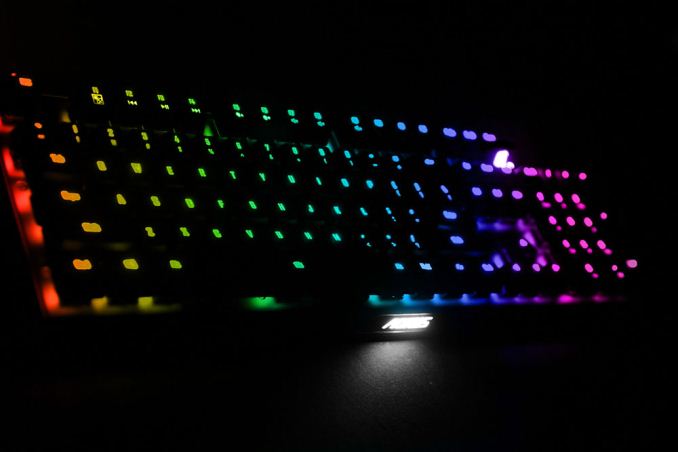
Related Reading:
- Best Mechanical Keyboards: Holiday 2017
- The Tesoro Excalibur SE Spectrum Review: A Mechanical Keyboard with Gateron Optical Switches
- Razer Announces BlackWidow Ultimate Keyboard: IP54 Dust & Splash Resistant Mechanical Keyboard
- Corsair Launches Splash-Resistant K68 Mechanical Keyboard
- Kailh Introduces Low Profile Mini ‘Chocolate’ Keyswitches
- Logitech’s G613 "Lightspeed" Wireless Mechanical Keyboard Cuts Wires & Input Lag
- The G.Skill KM570 ΜΧ Mechanical Keyboard Review: Sturdy & Efficient
More...
-
11-29-17, 12:48 PM #7578
Anandtech: Samsung Starts Mass Production of Chips Using 10nm Low Power Plus (10LPP)
Samsung Foundry on Wednesday revealed that it has started mass production of SoC products using its second generation 10 nm Low Power Plus (10LPP) fabrication technology. The new manufacturing process will enable developers of chips to reduce power consumption or increase performance of their products compared to the first-gen 10 nm tech (10LPE).
Like previous node updates from Samsung, the new 10LPP fabrication process promises a range of improvements depending on what a customer is looking for. On the performance front the process is said to offer 10% higher performance at the same complexity and power, or alternatively, customers can design for an up to 15% reduction in power consumption at the same frequency and complexity. Samsung Foundry does not disclose how it managed to improve the 10LPP vs. the 10LPE, but it is logical to assume that the company had to optimize the transistor structure somehow. Samsung’s 10LPP and 10LPE technologies are still very similar from design rules and manufacturing points of view, so experience obtained with the former will be applicable to the latter.
Samsung Foundry says that SoCs made using the 10LPP process technology will be used in devices to be launched early next year and onwards. The contract maker of semiconductors does not officially disclose which chips it is producing using the 10LPP process technology, but since it uses plural (“SoC products”), it all but given that there are more than one 10LPP SoC model in production. One of the candidates to be produced using the 10LPP is Samsung’s own Exynos 9 Series 9810 SoC that is expected to power the company’s 2018 flagship Galaxy S smartphones. Typically, Qualcomm also adopts Samsung’s latest process technologies along with the South Korean giant itself (to a large degree because its chips are used inside flagship Galaxy handsets too), but so far, Qualcomm has not made any announcements concerning the 10LPP.Advertised PPA Improvements of New Process Technologies
Data announced by companies during conference calls, press briefings and in press releases14LPP
vs 28LPP10LPE
vs 14LPE10LPE
vs 14LPP10LPP
vs 10LPE10LPU
vs
10LPE8LPP
vs 10LPPPower 60% 40% 30% ~15% ? 10% Performance 40% 27% >10% ~10% ? ? Area Reduction 50% 30% 30% none ? 10%
Keeping in mind that while Samsung Foundry’s LPE process technologies are used primarily by Samsung itself and a very limited number of its customers, the LPP processes are adopted by a considerably larger group of clients. So the launch of the 10LPP means expanded usage of the company’s 10 nm node in general. In order to meet demand, Samsung will start to make SoCs using the 10LPP in its new S3 fab located in Hwaseong, Korea.
Meanwhile, the evolution of Samsung’s 10 nm node is not going to stop with the formal introduction of the 10LPP. Going forward, Samsung plans to introduce the 10LPU fabrication technology for ultra-low-power SoCs as well as the 8LPP manufacturing process for advanced SoCs. Samsung yet has to detail the 10LPU, but with the 8LPP it promises a 10% area reduction (at the same complexity) as well as a 10% lower power consumption (at the same frequency and complexity) compared to the 10LPP process due to narrower metal pitches and other optimizations.
“We will be able to better serve our customers through the migration from 10LPE to 10LPP with improved performance and higher initial yield,” said Ryan Lee, vice president of foundry marketing at Samsung Electronics. “Samsung with its long-living 10nm process strategy will continue to work on the evolution of 10nm technology down to 8LPP to offer customers distinct competitive advantages for a wide range of applications.”
Related Reading:
- Samsung’s 8LPP Process Technology Qualified, Ready for Production
- Samsung Foundry Announces 10nm SoC In Mass-Production
- Samsung Announces Second-Gen 14nm Low Power Plus (14LPP) Process Now In Mass Production
- Samsung and TSMC Roadmaps: 8 and 6 nm Added, Looking at 22ULP and 12FFC
- GlobalFoundries Adds 12LP Process for Mainstream and Automotive Chips; AMD Planning 12LP CPUs & GPUs
- GlobalFoundries Details 7 nm Plans: Three Generations, 700 mm², HVM in 2018
More...
-
11-29-17, 12:48 PM #7579
Anandtech: Intel to Update Xeon D in Early 2018, with Skylake-SP Cores
One of the interesting sub-announcements to come out of Intel’s EPYC benchmark numbers was a slide on the ‘momentum’ of Intel’s new Xeon Scalable Platform using Skylake-SP cores. Alongside the notice of ‘110+ performance world records’ and ‘200 OEM systems shipping’ was a side note on the next iteration of Xeon-D, which will be getting the latest enterprise Skylake-SP cores.
More...
-
11-29-17, 03:07 PM #7580
Anandtech: EKWB Announces EK-MLC Phoenix AIO: Modular and Expandable Liquid Cooling F
This week EKWB has taken the wraps off of a new lineup of pre-filled products for liquid cooling, which the company is naming the MLC Phoenix family. The Phoenix lineup was created to cater to customers who may be unwilling to assemble a full custom loop, or simply do not have time to maintain a custom loop but still would like a premium cooling solution. Its modular design allows for ease of expansion for using any one of several of its pre-filled water blocks. All of the Phoenix products utilize zero-drop quick disconnect couplings between parts to allow for quick and spill-free changes of the water-cooling loop.
The loop will consist of at least two parts. First is the radiator core module containing the pump and radiator, then your cooling modules of choice, either CPU or Video Card modules, or, both. The radiator core module, a high-fin density EK-CoolStream radiator, comes pre-filled and includes the pump, as well as high-static pressure EK-Varder EVO fans. Unique to this setup, the radiator core modules include an integrated fan splitter hub to help reduce cable clutter. The pump and fans plug into the hub with only one PWM cable need to be plugged into the CPU fan header and one SATA Molex power cable. The radiator core modules have five options: 120mm, 240mm, 360mm, 140mm, and 280mm so there is to fit most cooling and space needs.
The CPU Cooling modules come in two flavors, one made for Intel and AM4 systems, and another designed specifically for the large AMD Threadripper CPUs. The Intel/AM4 solution supports Intel LGA1150/1151/1155/1156/2011-3/2066 sockets while the sTR4 model is compatible with AMD SocketTR4 (Socket SP3r2) and AMD Socket SP3 based motherboards. EK states the pre-filled CPU cooling module is based on the EK-Supremacy series of water blocks, comes with an error-preventing mounting mechanism for an easier installation, have low hydraulic restriction, and of course mates perfectly with all EK-MLC Phoenix radiator core modules.
As for the EK-MLC GPU cooling modules, there are 23 to choose from with more being added. These are designed to fit NVIDIA and AMD cards from the Geforce GTX 1070 to the TitanX Pascal on the NVIDIA side, Radeon RX Vega cards on the AMD side. The blocks are made from high-purity copper and directly cool the GPU, RAM (HBM2), and well as the VRM. It has a central inlet split-flow cooling engine designed for good hydraulic performance for use with its other MLC Phoenix parts. All blocks are equipped with a rotary terminal allowing the integrated tubing to rotate on their mount point for more flexibility when routing the loop. Most all EK-MLC GPU cooling module full cover blocks are available in Nickel Plexi and Nickel Acetal versions with the base of the blocks made of nickel plated electrolytic copper. The plexi variants also have two pre-drilled slots for 3mm LED diodes. All EK-MLC parts will come with a two-year warranty.
All EK-MLC products are currently available for pre-order through the EK-MLC configurator with shipping to start Monday, December 4th.
Related Reading:EKWB Phoenix MLC AIO Family CPU Cooling Modules MSRP (incl. VAT) / USD EK-MLC Phoenix CPU Module - Intel/AM4 66.90€ / $79.99 EK-CoolStream SE 560 59.90€ / $69.90 Radiator Core Modules EK-MLC Phoenix 120 Radiator Core Module 139.90 € / $149.90EK-MLC Phoenix 240 Radiator Core Module 169.90€ / $179.99EK-MLC Phoenix 360 Radiator Core Module 189.90€ / $194.99EK-MLC Phoenix 140 Radiator Core Module 139.90€ / $149.90EK-MLC Phoenix 280 Radiator Core Module 139.90€ / $149.90GPU Cooling Modules EK-MLC GPU Module FC Titan X Pascal - Nickel 134.90€ / $144.99EK-MLC GPU Module FC 1080 GTX Ti - Nickel 134.90€ / $144.99EK-MLC GPU Module FC 1080 GTX Ti Strix - Nickel 145.90€ / $155.99EK-MLC GPU Module FC Geforce GTX FE - Nickel 124.90€ / $135.99EK-MLC GPU Module FC Radeon Vega - Nickel 134.90€ / $144.99EK-MLC GPU Module FC 1080 GTX Ti FTW3 - Nickel 134.90€ / $144.99EK-MLC GPU Module FC 1080 GTX Ti Aorus - Nickel 129.90€ / $139.99EK-MLC GPU Module FC 1080 GTX Strix - Nickel 145.90€ / $155.99EK-MLC GPU Module FC 1080 GTX TF6 - Nickel 134.90€ / $144.99EK-MLC GPU Module FC 1080 GTX - Nickel 124.90€ / $135.99EK-MLC GPU Module FC 1080 GTX G1 - Nickel 129.90€ / $139.99EK-MLC GPU Module FC 1080 GTX FTW2 - Nickel 134.90€ / $144.99EK-MLC GPU Module FC 1070 GTX - Nickel 124.90€ / $135.99EK-MLC GPU Module FC 1080 GTX Ti TF6 - Acetal + Nickel 135.90€ / $145.99EK-MLC GPU Module - FC 1080 GTX Ti - Acetal + Nickel 124.90€ / $135.99EK-MLC GPU Module FC 1080 GTX Ti Strix - Acetal + Nickel 145.90€ / $155.99EK-MLC GPU Module FC Radeon Vega - Acetal + Nickel 134.90€ / $144.99EK-MLC GPU Module FC Geforce GTX FE - Acetal + Nickel 124.90€ / $135.99EK-MLC GPU Module FC 1080 GTX Ti FTW3 - Acetal + Nickel 134.90€ / $144.99EK-MLC GPU Module FC 1080 GTX Ti Aorus - Acetal + Nickel 129.90€ / $139.99EK-MLC GPU Module FC Titan X Pascal - Acetal + Nickel 134.90€ / $144.99EK-MLC GPU Module FC 1080 GTX TF6 - Acetal + Nickel 134.90€ / $144.99EK-MLC GPU Module FC 1080 GTX G1 - Acetal + Nickel 129.90€ / $139.99- Enermax Launches LiqTech TRO AIO LCS for AMD's Threadripper: 100% IHS Coverage, 500W TDP
- The Fractal Design Celsuis S24 & S36 AIO Coolers Review
- EKWB Releases 420mm and 560mm CoolStream Slim Radiators
- EKWB Unveils Threadripper Edition EK Supremacy EVO CPU Water Blocks
- EKWB Releases New Varder EVO Fan with Start-Stop Function
More...
Thread Information
Users Browsing this Thread
There are currently 18 users browsing this thread. (0 members and 18 guests)




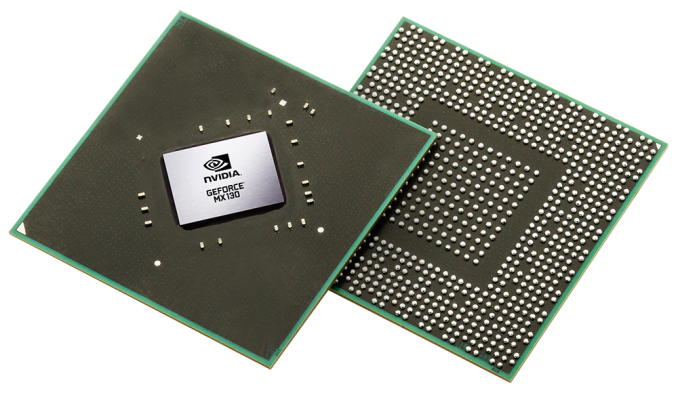

 Quote
Quote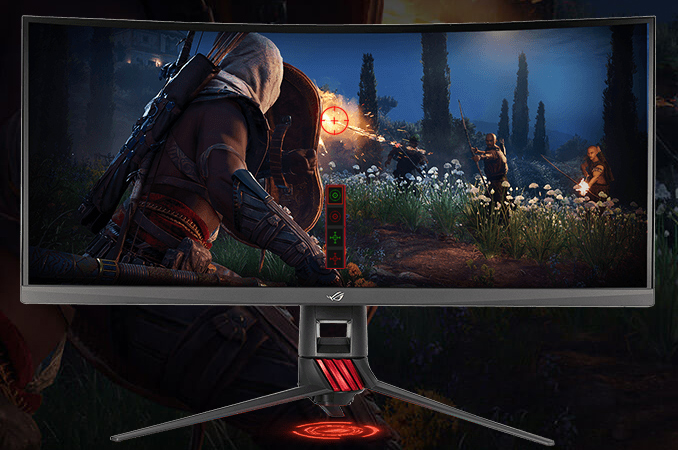
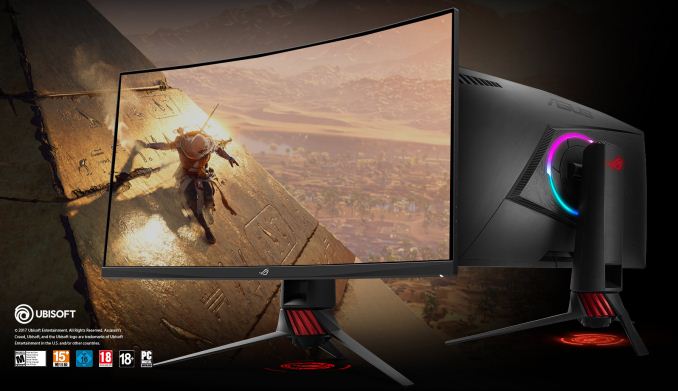
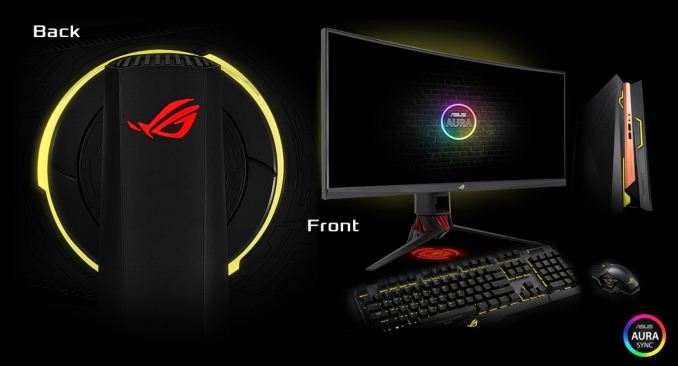
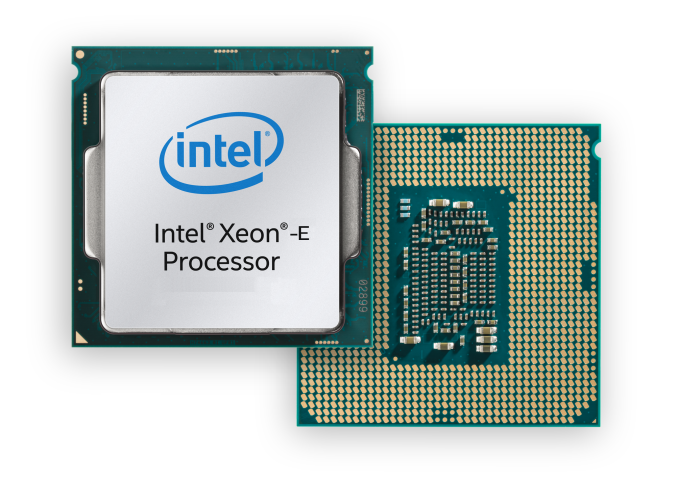
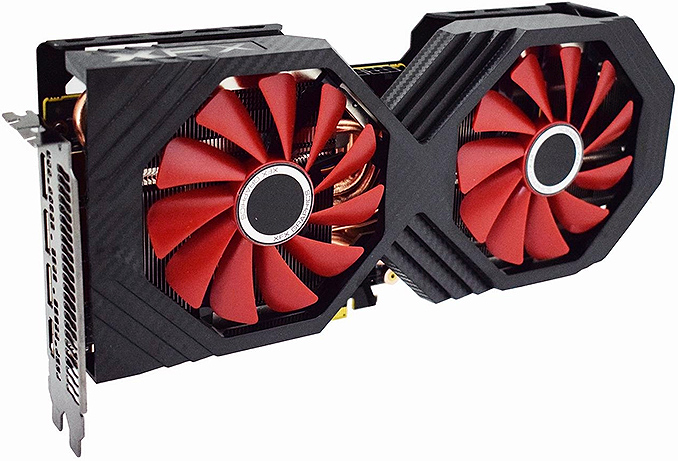
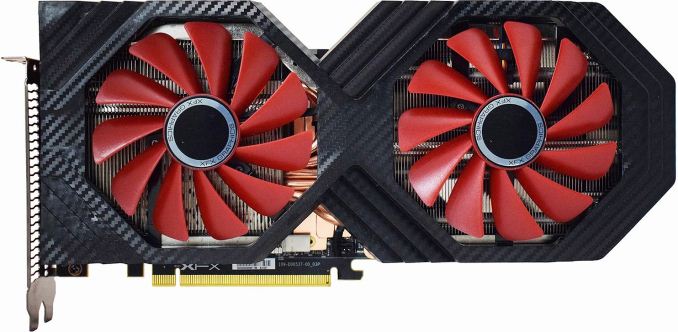

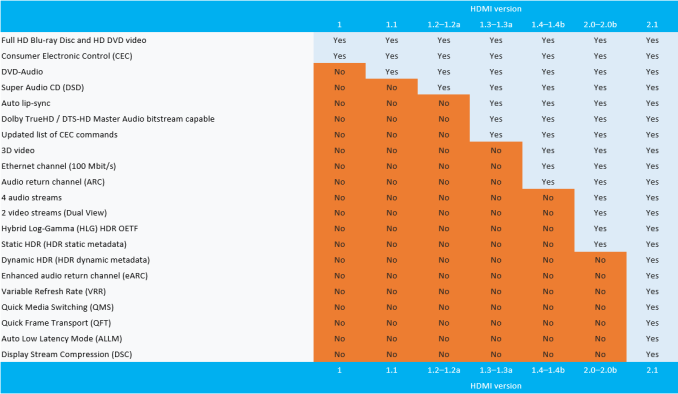
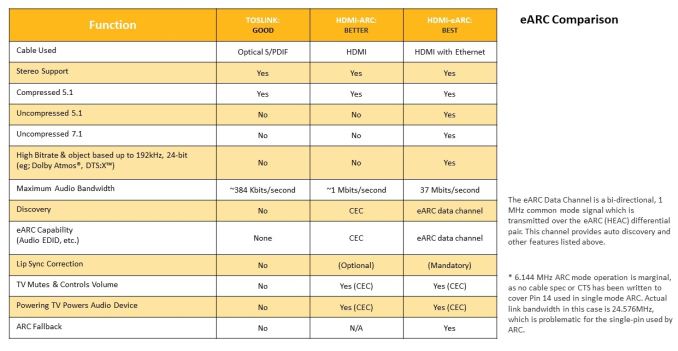
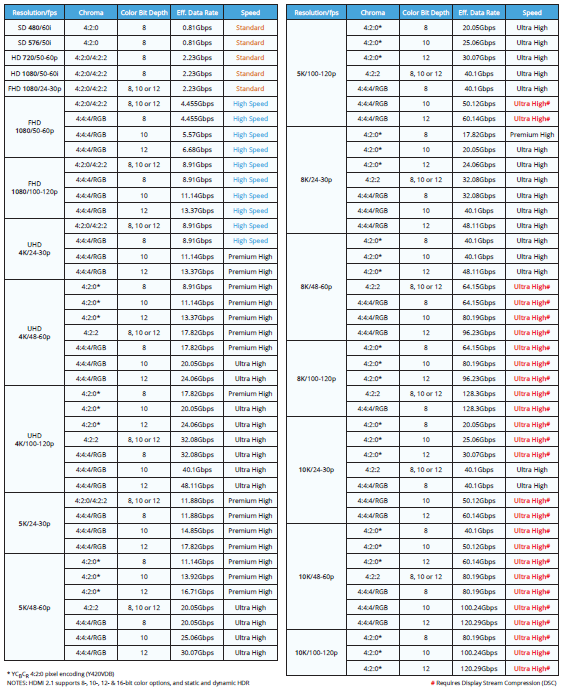
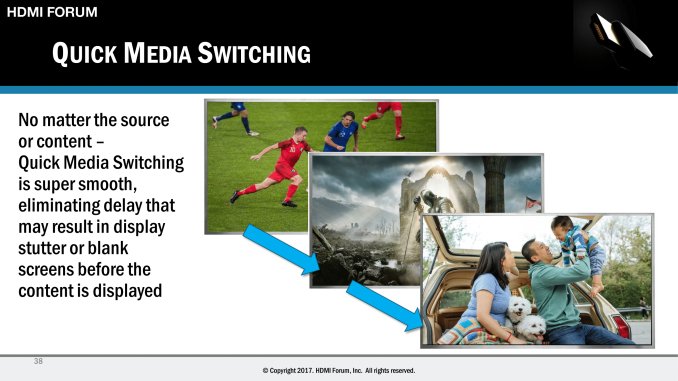
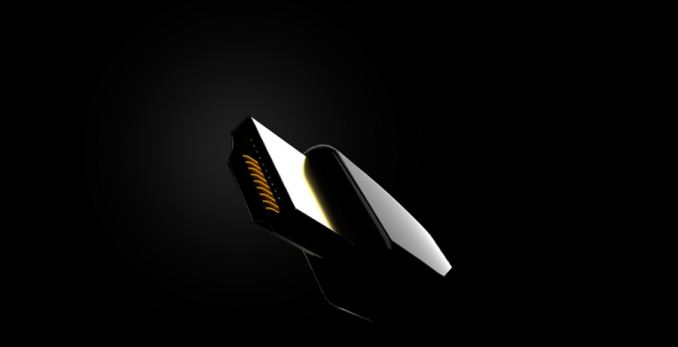



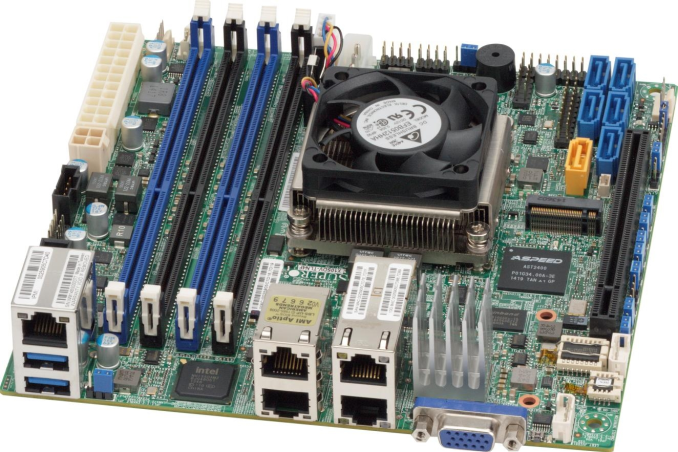

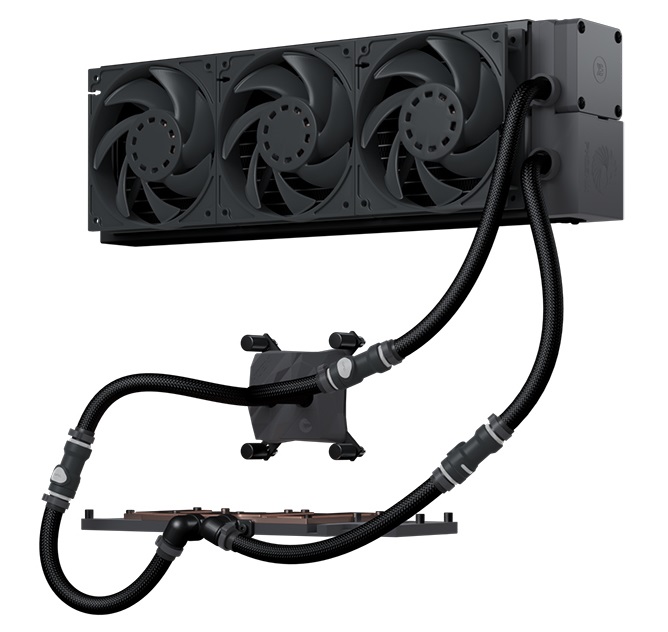
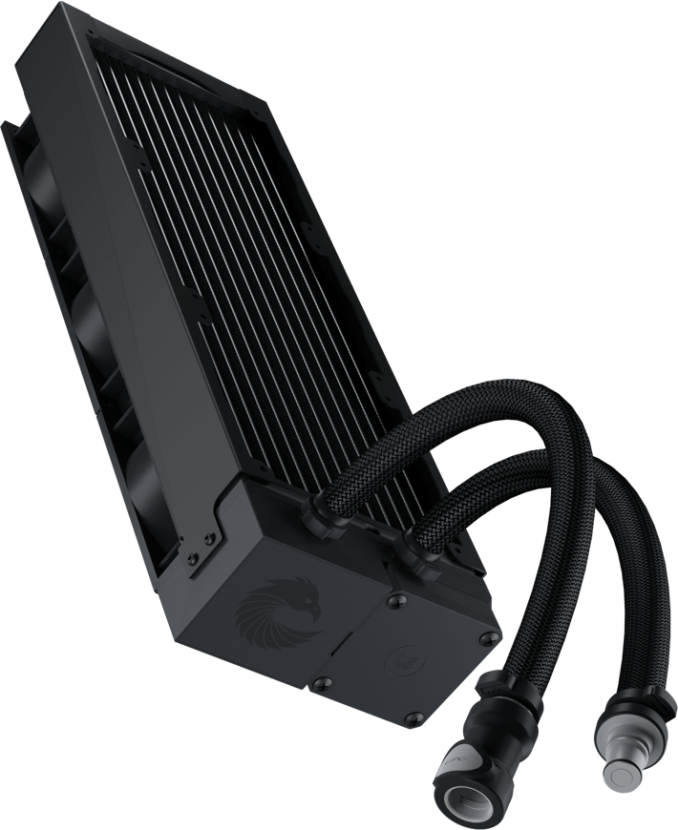

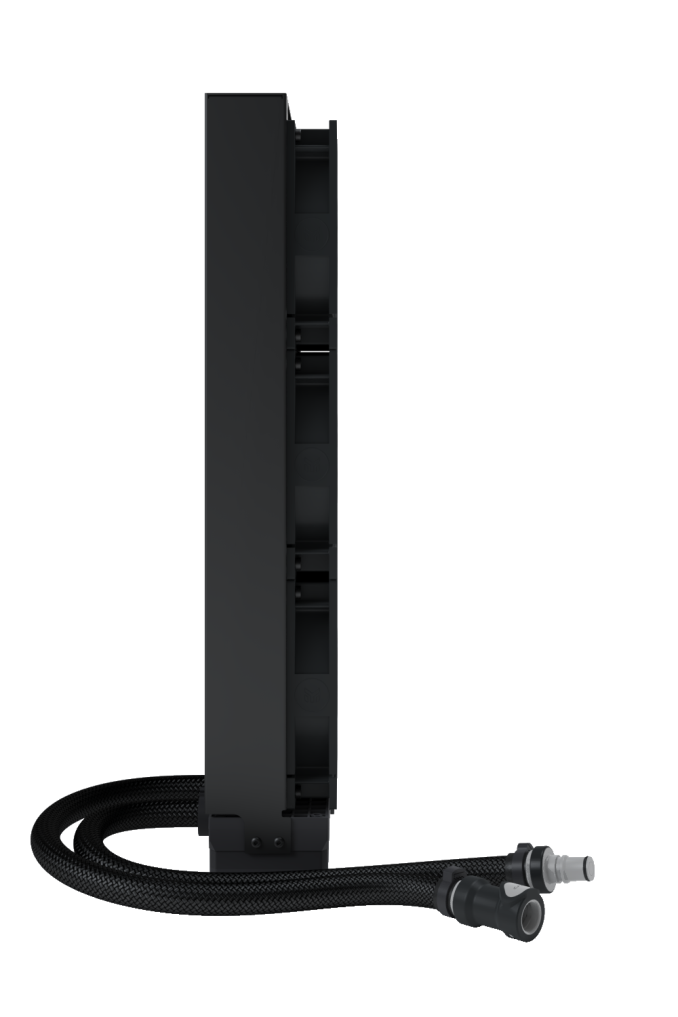
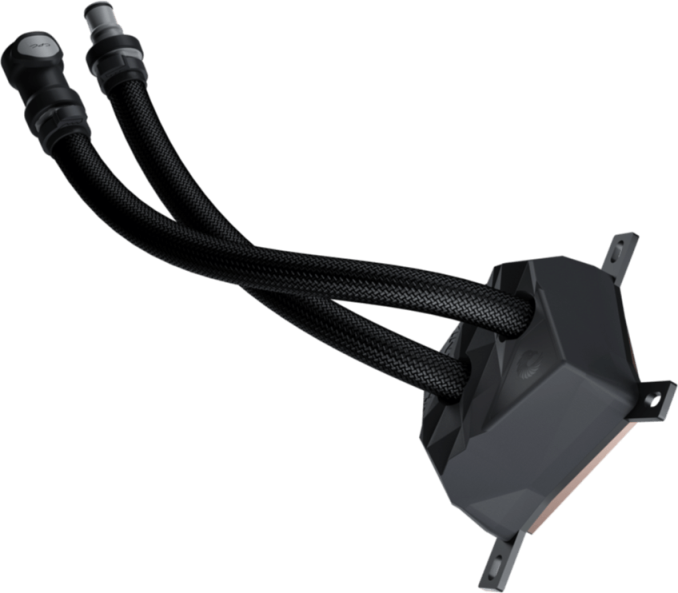
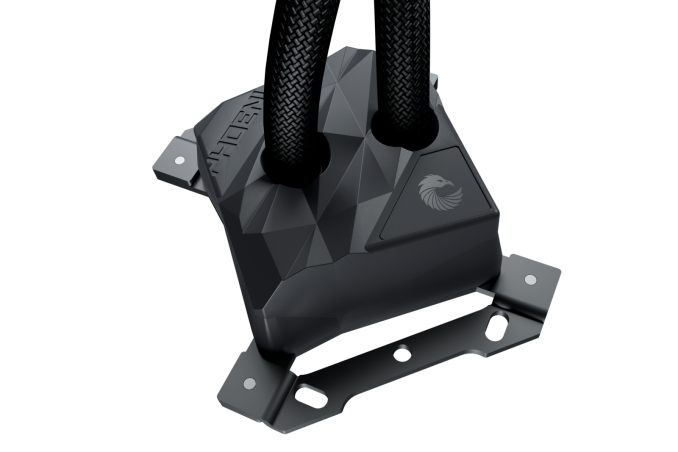

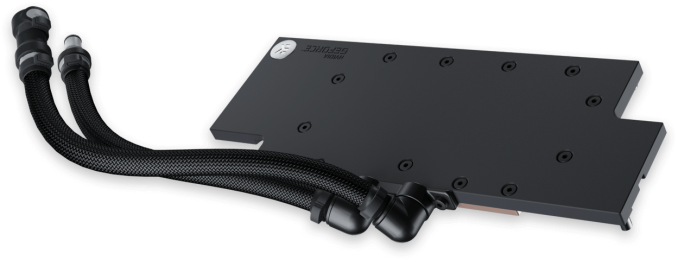
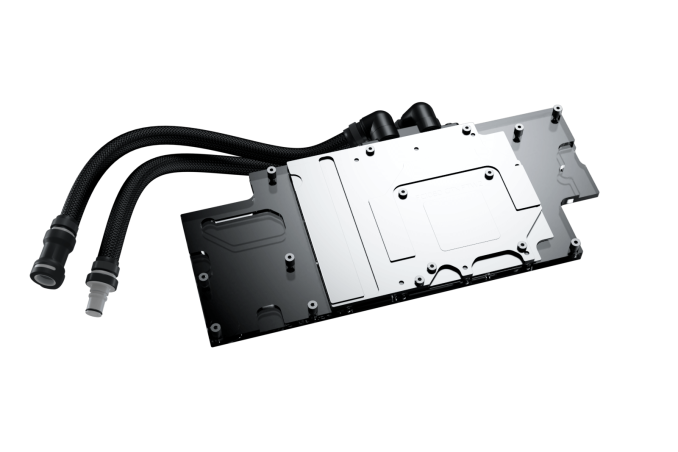
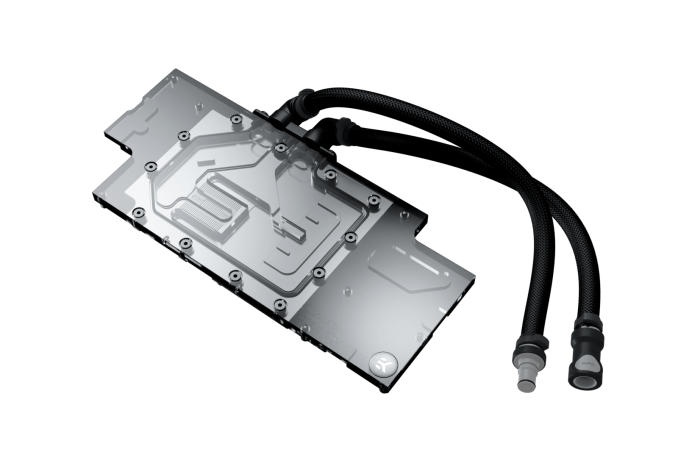
















Bookmarks